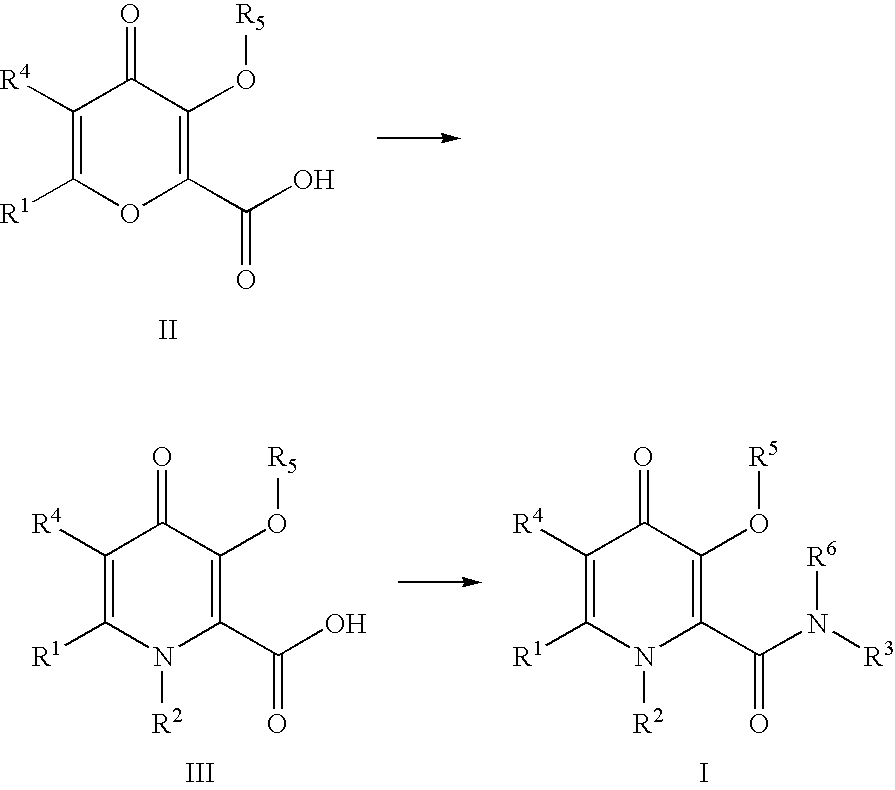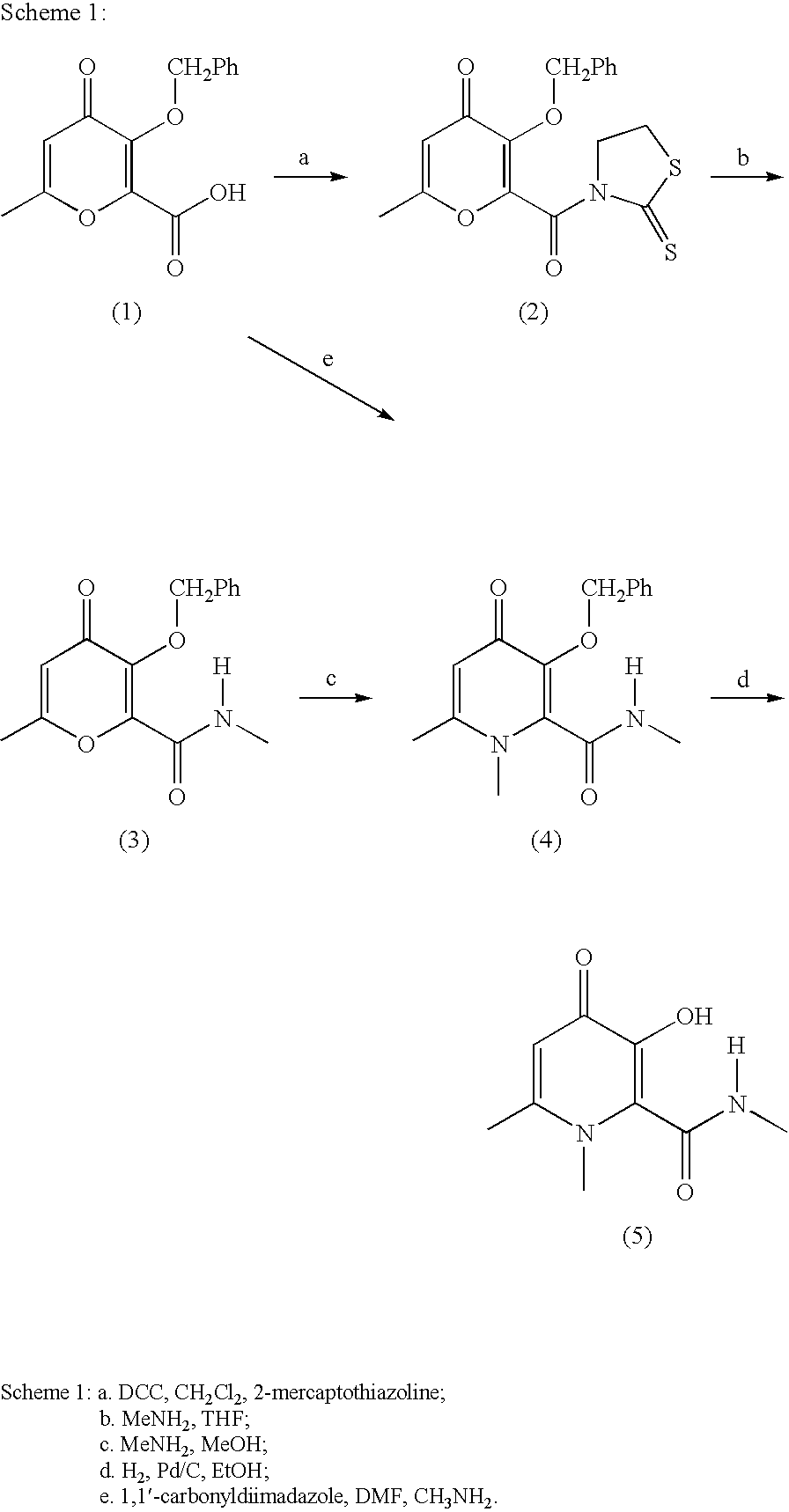Process For The Manufacture Of 3-Hydroxy-N-Alkyl-1-Cycloalkyl-6-Alkyl-4-Oxo-1,4-Dihydropyridine-2-Carboxamide And Its Related Analogues
a technology of dihydropyridine and n-alkyl, which is applied in the direction of heterocyclic compound active ingredients, biocide, chemical production, etc., can solve the problems of less than 60% yield, toxic and/or hazardous waste disposal, and difficult to achieve the effect of reducing the amount of r2nh2, cost-effective and eliminating the costly aspect of toxic methanol waste disposal
- Summary
- Abstract
- Description
- Claims
- Application Information
AI Technical Summary
Benefits of technology
Problems solved by technology
Method used
Image
Examples
example 1
Preparation of 3-benzyloxy-1-cyclopropyl-6-methyl-4-oxo-1,4-dihydro-pyridine-2-carboxylic acid
Procedure I
[0057] To a suspension of 3-(benzyloxy)-6-methyl-4-oxo-4H-pyran-2-carboxylic acid (70 g, 0.27 mol) in MeOH (350 mL) in a 3-necked RBF (round bottom flask) fitted with a mechanical stirrer was added cyclopropylamine (120 mL, 1.72 mol). A clear light yellow solution resulted. The reaction mixture was refluxed for ca. 19 h. Volatile solvents were removed in vacuo and the residue was dissolved in water (700 mL) with stirring. The aqueous mixture was filtered through a pad of Celite®. The filtrate was placed in a 3-necked RBF fitted with a mechanical stirrer, and cooled in an ice bath. Conc. HCl was added until the pH was ca. 1-2, and voluminous “orange” solid precipitated out. Acetone (200 mL) was added to the suspension. The solid was then collected by suction filtration, thoroughly washed with acetone, and air-dried. The title compound was obtained as an off-white solid (71.0 g,...
example 2
Preparation of 3-(benzyloxy)-1,6-dimethyl-4-oxo-1,4-dihydropyridine-2-carboxylic acid methylamine salt
[0060] As described previously, a 2 M methylamine solution in methanol (5.8 ml, 11.6 mmol) was added to a suspension of the 3-(benzyloxy)-6-methyl-4-oxo-4H-pyran-2-carboxylic acid (1.0 g, 3.84 mmol) in methanol (3 ml) at room temperature. The resulting solution was sealed, and then heated at 70° C. for overnight. A clear yellow solution was observed. The titled compound was obtained as a light yellow solid after solvent was removed by reducing pressure (1.02 g, 87% yield). 1H NMR (DMSO-D6) δ(ppm): 7.8 (br, 2H), 7.49 (m, 2H), 7.3 (m, 3H), 6.03 (s, 1H), 4.91 (s, 2H), 3.47 (s, 3H), 2.35 (s, 3H), 2.24 (s, 3H); MS (m / z): 274 (C15H16NO4+).
[0061] The following compounds are prepared in a similar fashion:
[0062] 3-Benzyloxy-1-ethyl-6-methyl-4-oxo-1,4-dihydropyridine-.2-carboxylic acid ethylamine salt
[0063]1H NMR (DMSO-D6) δ(ppm): 7.90 (br, 2H), 7.48 (m, 2H), 7.30 (m, 3H), 6.00 (s, 1H), 4...
example 3
Preparation of 3-benzyloxy-1-cyclopropyl-6-methyl-4-oxo-1,4-dihydro-pyridine-2-carboxylic acid methylamide
Procedure I:
[0074] To a cold suspension (ice-salt bath, internal temp.=4° C.) of 3-benzyloxy-1-cyclopropyl-6-methyl-4-oxo-1,4-dihydro-pyridine-2-carboxylic acid (150.49 g, 0.50 mol), dichloromethane (750 mL) and dimethylformamide (3.9 mL, 0.05 mol) in a 3N-RBF fitted with a mechanical stirrer was added oxalyl chloride (58.0 mL, 0.66 mol) drop wise over a period of 1 h. The internal temperature was kept at below 10° C. during the addition. After addition of about 30 mL of oxalyl chloride, a dark red solution resulted. The reaction was monitored by thin layer chromatrography (TLC, eluent: CH2Cl2 / MeOH, 9 / 1 ratio). The complete consumption of starting material was observed within 15 min after the addition of oxalyl chloride.
[0075] In another 5 L 3N-RBF fitted with a mechanical stirrer was placed dichloromethane (1250 mL), triethylamine (180.0 mL, 1.291 mol) and a solution of 2M ...
PUM
| Property | Measurement | Unit |
|---|---|---|
| Acidity | aaaaa | aaaaa |
Abstract
Description
Claims
Application Information
 Login to View More
Login to View More - R&D
- Intellectual Property
- Life Sciences
- Materials
- Tech Scout
- Unparalleled Data Quality
- Higher Quality Content
- 60% Fewer Hallucinations
Browse by: Latest US Patents, China's latest patents, Technical Efficacy Thesaurus, Application Domain, Technology Topic, Popular Technical Reports.
© 2025 PatSnap. All rights reserved.Legal|Privacy policy|Modern Slavery Act Transparency Statement|Sitemap|About US| Contact US: help@patsnap.com



